
Right now, truck manufacturers are looking closely into California’s proposed rule regarding the sale of electric trucks.
California environmental regulators are working to determine the best way to move forward with a plan requiring truck manufacturers to start selling zero-emission vehicles within the next four years.
The California Air Resources Board’s Advanced Clean Truck Regulation, the first proposal of its kind in the nation, would bring about these sales by 2024, but would not force fleets to purchase vehicles of this kind or require a particular zero-emissions technology to be put in place.
“Zero-emission technology continues to improve rapidly, and costs continue to come down,” said CARB in a proposal summary.
The regulation, which was presented by staff to CARB earlier this month, would require 3% of Classes 7-8 trucks sold by large truck manufacturers to be zero-emission vehicles by their 2024 models, and 15% to be zero-emission by 2030. Other manufacturing companies producing models such as refuse trucks and step vans would need to have a certain percentage of zero-emission trucks by 2024 as well.
For straight trucks, the number jumps from 7% in 2024 to a whopping 50% by 2030.
The proposal would also mean California carriers with gross revenues of over $50 million, or that own more than 100 8,500-pound trucks, must report their vehicle activity by April 1st, 2021, with a detailed description of the vehicles assigned to their facilities.
CARB accepted public comments on the proposal until December 9th, and had a public hearing on the regulation December 12th. The final vote is anticipated for next year.
However, as of now, the industry is divided regarding the proposal. The hearing’s commentators included believers that this plan would try to implement the new technology far too quickly, as well as those saying it hasn’t been put into place fast enough.
“Our goal here is to transform the transportation system,” said Mary Nichols, CARB’s board chairman. “It’s not just to meet a target. We need to move as fast as we can without screwing things up. This is tough stuff. If it were easy, it would have been done by now.”
California has offered rebates in an attempt to offset higher sticker prices for hybrid and zero-emission trucks. CARB, though, recently announced that the Hybrid and Zero-Emission Truck and Bus Voucher Incentive Project has a wait list that currently exceeds the fiscal 2019-20 budget’s funding.
In late October, CARB announced its program’s new attempts to better “align eligible technologies with HVIP goals.”
CARB also released a fact sheet regarding the proposal, which detailed more than 70 models of zero-emissions trucks, vans, and buses that are currently commercially available. California also has funding assistance available for technologies such as these through multiple programs.
“As technology advances, zero-emission trucks will become suitable for more applications.” said CARB. “Most major truck manufacturers have announced plans to introduce market ready zero-emission trucks in the near future.
Regardless, the ability to convert the entire industry from diesel to electric–which is the goal in California by 2045–seems extraordinarily difficult.
“We support zero-emissions vehicles,” said Jed Mandel, president of the Truck and Engine Manufacturers Association, at the hearing. “But designing a program based on a naked sales mandate is fundamentally flawed. Trucks are not cars.”
His suggestion was that CARB starts with the segments of the trucking industry that have the ability to implement the technology now, such as step vans and buses, rather than heavy longhaul trucks.
“There’s a great deal of intrigue when it comes to electric trucks, but not a lot of experience,” said American Trucking Associations’ California-based director of environmental research, Mike Tunnell. “There’s hope and anticipation that these vehicles will be able to stand up to the daily demands of the industry in terms of range, durability, and reliability.”
He also said that trucking companies are only evaluating prototypes right now.
“We are just beginning the stages of understanding the challenges and opportunities that this technology presents,” Tunnell explained.
CARB board member Hector De La Torre agreed.
“I think the key is availability,” he said. “From what I’m hearing, it won’t be until the mid-2020s that commercial trucks will be available. I’m talking longhaul [Class] 7s and 8s. So, we’re not there yet with those, clearly.”




